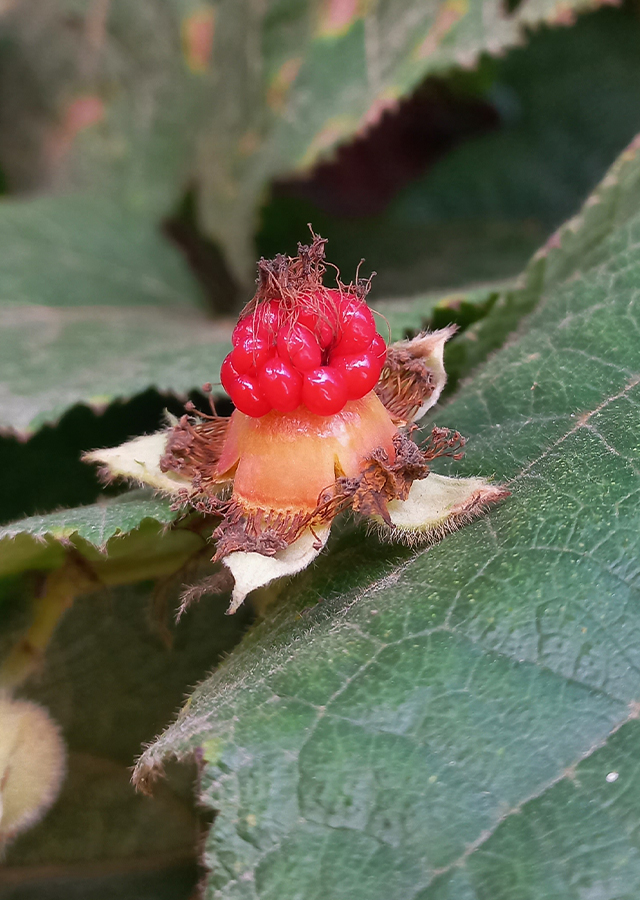Wild Raspberry
Rubus moluccanus L.
Rosaceae
Location in our garden
Principal



Synonym
-
Habitus
Shrubs. A climbing, straggling, prickly perennial shrub, producing a cluster of stems up to 6 m, occasionally 10 m long from a woody rootstock; the plant is usually around 2-3 m tall
Part Used
Leaves
Fruit
Sap
Growing Requirements
Full Sunshine
Need Shade
Habitat
Forest
Shrublands
Overview
Rubus moluccanus is native to tropical Asia, South-East Asia, and eastern Australia. The stems and leaves are armed with medium-sized spines. The stems can root and produce new plants where they touch the ground, the plant forming thickets of growth. The plant is harvested from the wild for local use as a food. It has a range of traditional medicinal uses and is also occasionally cultivated for its edible fruit. It has sour flavor, used in jams and sauces. And the fruit yields a purple dye.
Vernacular Names
Grosse ronce (French), Jutulipoka (Assamese), Bipemkanta (Nepalese), Sapinit (Tagalog-Philippines).
Agroecology
Grows in rainforest edges in Australia. Found at elevations up to 2,100 m in Himalayas. Found on various soils in forest edges, secondary forest and thickets, from sea-level up to 2,000 m, occasionally to 3,000 m. In the temperate zone it can only be grown in regions with mild winters. Easily grown in a good well-drained loamy soil in sun or semi-shade.
Morphology
- Stem - branches covered by wooly hairs. Stems, buds, petioles, and lower surfaces of the leaves are velvety.
- Leaves - thin, flat, usually 3- to 5-lobed, deeply cordate at the base, broadly ovate, and 5 to 15 cm wide. Upper surface is hairy and prominently reticulate when dry.
- Flowers - about 2 cm across, usually in small clusters, and borne in racemes at the axils of leaves and at the ends of branches. Calyx lobes are ovate to lanceolate, entire or pectinate. Petals are obovate, white, and shorter than the calyx segments.
- Fruit - berries are bright red, about 1 cm in diameter, succulent, slightly acid, with numerous carpels, and hairy receptacle.
Cultivation
- Generative propagation is by seed - germinates best if given a period of cold stratification prior to sowing in containers. Stored seed requires one month stratification at about 3 °C and is best sown as early as possible in the growing season. Prick out the seedlings when they are large enough to handle and grow on until large enough to plant out.
- Vegetative propagation is by cuttings of half-ripe wood in a frame, tip layering towards the end of the growing season, and by division just before the plant comes into new growth or as it enters dormancy.
Chemical Constituents
Alkaloids, amino acids (malic and citric acids), flavonoids, phenolic compounds, tannins, glycosides, saponins, and other compounds.
Traditional Medicinal Uses
- In Papua New Guinea, heated leaves are applied to the abdomen for abdominal pain.
- Leaves and fruit are used for diarrhea.
- Sap from the leaves or stems is used to treat eye diseases.
- Leaves part of a herbal leaf concoction used for abdominal pain. Decoction of tender shoots with leaves, fruit, seed kernerl, aerial parts of other plants used for peptic ulcer disease.
- Malays use the fruit as remedy for nocturnal micturition in children.
Part Used
Reference Sources
- Fern, Ken. (2021). Useful Tropical Plants Database: Rubus moluccanus L. https://tropical.theferns.info/viewtropical.php?id=Rubus+moluccanus. 11-12-2021.
- Kew Royal Botanic Gardens. (N0 date). Plants Of the World Online: Rubus moluccanus L. https://powo.science.kew.org/taxon/urn:lsid:ipni.org:names:738460-1. 11-12-2021.
- Stuartxchange. (2018). Philippine Medicinal Plants: Sapinit. http://www.stuartxchange.org/Sapinit.html. 11-12-2021.

